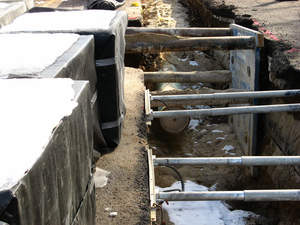DENVER, CO--(Marketwired - Jan 14, 2014) - EPS Geofoam is proving itself as a material with great potential for protecting pipelines from seismic activity. Steven Bartlett, associate professor of civil engineering at the University of Utah, and his team have been examining geofoam's mitigating effects on pipeline damage due to seismic faulting since 2007. According to Bartlett, high-pressure gas lines are one of the most important items to protect. "If they rupture and ignite, you essentially have a large blowtorch, which can be catastrophic," explains Bartlett.
"During the summer of 2007, Questar Gas Company requested that the University of Utah evaluate a conceptual EPS Geofoam cover system for a steel, natural gas pipeline crossing the Wasatch fault in the Salt Lake City valley," explained Bartlett. "The fault rupture is expected to produce an earthquake with a potential magnitude of 7.5 and several feet of potential fault offset at the pipeline crossing."
Many buried pipelines lay under six to eight feet of soil. Bartlett and his students at the University of Utah showed that a pipeline protected with a lightweight geofoam cover could withstand the fault offset and reduce the force on the pipe by up to four times the amount of force as a pipeline covered with conventional soil backfill.
When the 37-mile long section of natural gas pipeline had to be replaced between Coleville and Ogden, Utah, approximately 20,000 cubic feet of ACH Foam Technologies' EPS Geofoam was specified to reduce movement, shears, axial forces and strains imposed on the pipeline. EPS types 22 and 15 were shipped from ACH Foam's local plant in Murray, Utah.
"Geofoam has a low mass density, which reduces the vertical and horizontal stresses on buried utilities and compressive soils," explained Terry Meier, geofoam expert at ACH Foam Technologies. "This reduction in loading and deformation will likely improve the performance of a pipeline during and after a major seismic event along the fault area. Geofoam is also used as a compressible inclusion for systems undergoing static, monotonic and dynamic loadings. Its controlled compression can be used to reduce earth pressure against buried structures as well as deformation induced by structural loadings. Bartlett's team confirmed that the loadings that cause compression may include static and dynamic lateral earth pressure swells, frost heave pressures, settlements of support soils, faulting, liquefaction, landslides and traffic loads," Meier added. For more information visit achfoam.com.
